One of the most distinctive birds in the world, the Spoon-billed Sandpiper hardly seems like an identification problem, but to pick one out of a flock of stints is really more difficult than you would think. Overall shape and size, color, and behavior are very similar to the stints. The spoon-shaped bill is surprisingly hard to see, and at a distance they just blend in.
The following comments all make comparisons to Red-necked Stint, which is the species most often seen with Spoon-billed Sandpiper, but any of the other dark-legged stints/peeps (Little Stint or Semipalmated or Western Sandpiper) could be substituted with almost no change in the comparisons. Western Sandpiper and some Semipalmated Sandpipers have long bills like Spoon-billed, but their bills are thinner and droop slightly. Red-necked Stint has the flattest back contour of any stint/peep, so in that context the Spoon-billed’s more rounded back is evident, but would probably be less obvious among the other stints/peeps.
The 1978 bird at Vancouver, BC, in direct comparison with Western Sandpipers, was said to be bulkier and to stand a little more upright with head higher. The spoon-shaped bill looked two-toned from the side, with the base of the bill reflecting light and looking bluish, while the flattened tip looked black (Sauppe et al. 1978).
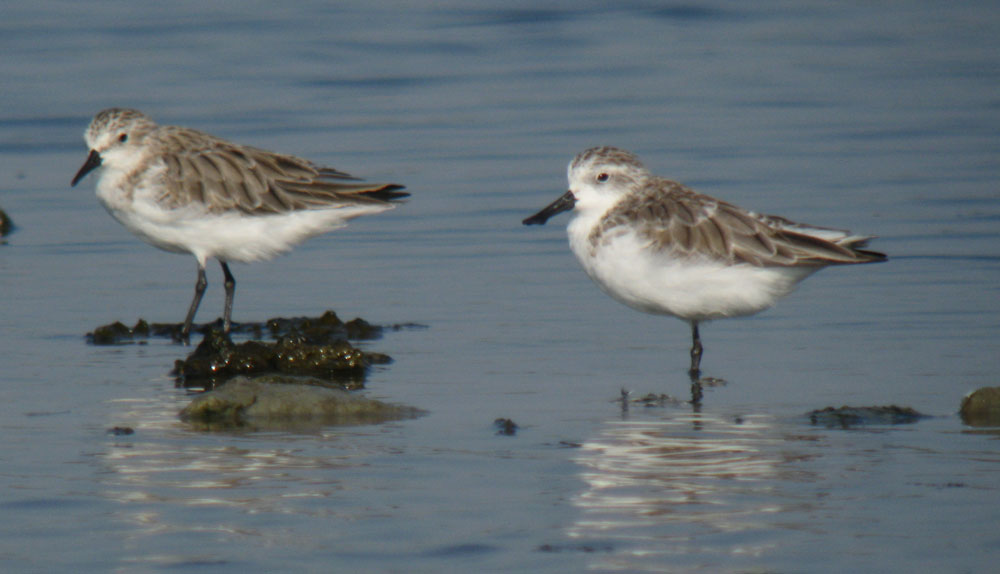
The spoon-shaped bill is a very distinctive and reliable field mark, when it’s visible. Other field marks are easier to see at a distance or at typical viewing angles, but these are more subjective and subtle, so in Thailand (Feb 2010) I often found myself identifying a bird as a “probable” Spoon-billed and then watching for a glimpse of the spoon-shaped bill to confirm that. Towards the end of my eight days there I developed more confidence, but the spoon-shaped bill remained the ultimate confirmation of an identification.
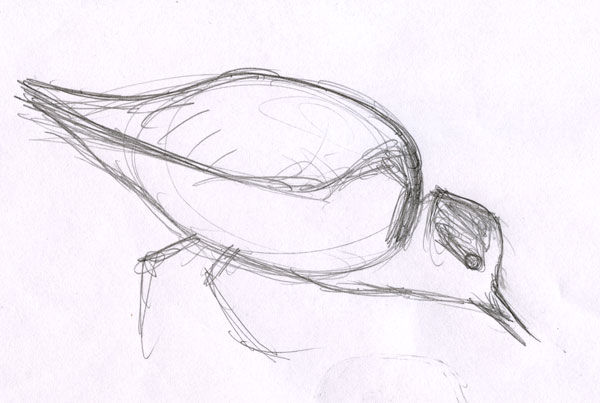
Overall shape and size: Spoon-billed Sandpiper is just fractionally bigger than Red-necked Stint, but significantly bulkier. It looks broad-shouldered, thick-necked, with deeper belly and rounder back than the stints. The head is relatively large and square.
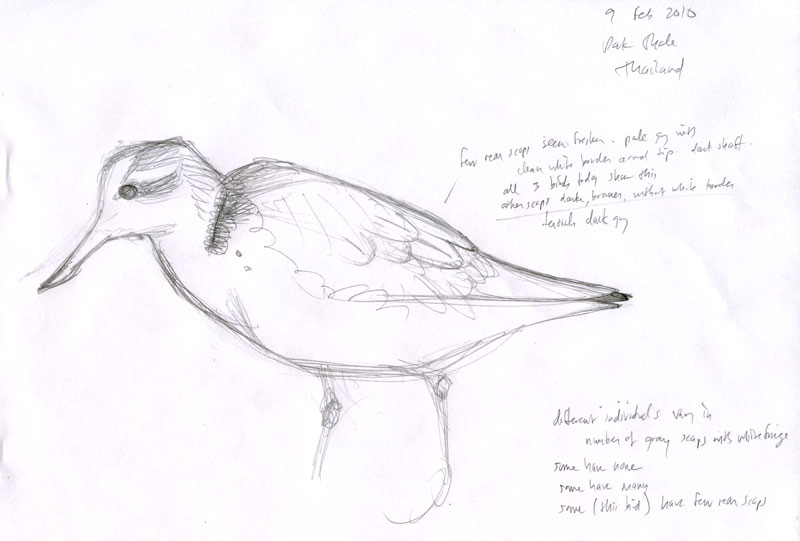
The broad bill tip is difficult to see except when the bird is facing towards or mostly away from you. It is not apparent in side view, but the bill itself is longer and much thicker than on a Red-necked Stint and often looks slightly upturned at the tip, so a very obvious and heavy black bill is a good indicator of a Spoon-billed Sandpiper.
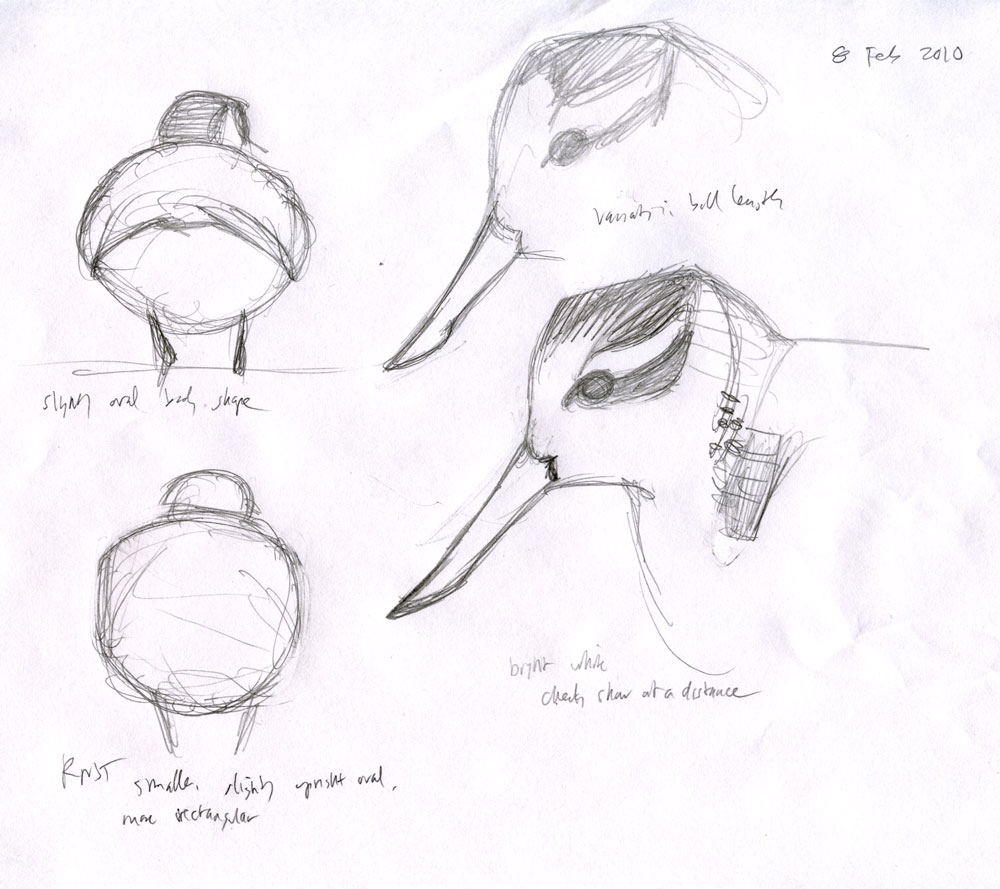
Spoon-billed Sandpiper viewed from behind shows a distinctly oval body shape, whereas Red-necked Stint has a more nearly circular body. When resting or sleeping a Spoon-billed Sandpiper looks thick-necked to the point of being hunch-backed.
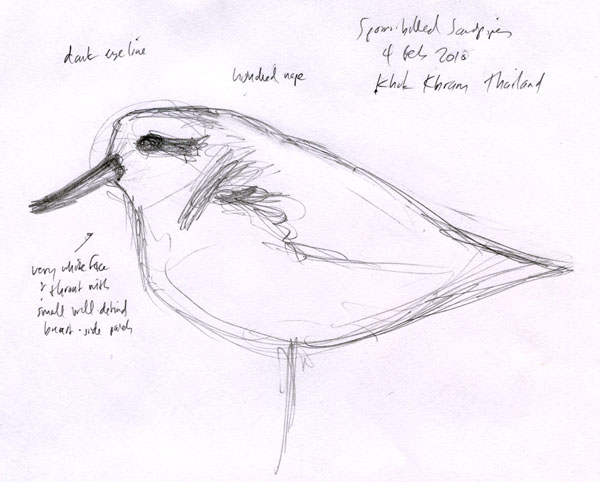
I had the impression that the legs were a little thicker than on Red-necked Stint, but this was not obvious. I kept trying to make the legs shorter than Red-necked Stint (just because that would fit the stocky overall impression), but in the end I never confirmed this and think they actually may be a little longer-legged than Red-necked Stint, given that the toes project beyond the tail tip in flight. Either way the leg length is very similar to the stints and they are usually in the water.
Plumage: The most obvious difference in plumage, and one of the best long-distance field marks, is the color and pattern of the head and breast. On Spoon-billed Sandpiper the face and breast are clean white, with relatively small and sharply-contrasting dark marks on the crown, cheeks, and breast-sides. The appearance of a small dark “mask” and white forehead, and white breast with small dark “spur” is distinctive for Spoon-billed Sandpiper. Red-necked Stint, like other small sandpipers, has more extensive dusky markings that blend into the surrounding white, so the area of clean white is greatly reduced.
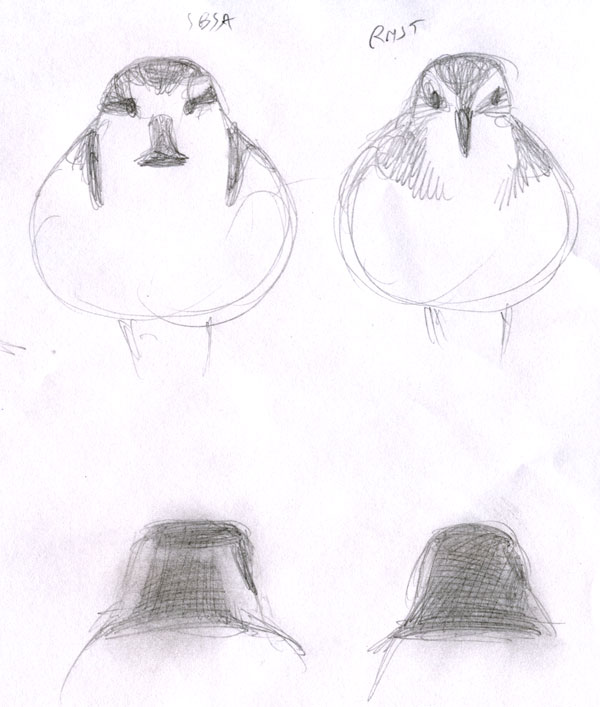
The pale whitish of the eyebrow and throat wrap completely around the back of the dark eye-patch (which is what sets it off as a patch), and create a very different appearance from the more uniformly gray head of the stints. When viewed from behind the Spoon-billed shows obvious pale whitish sides of the neck, meeting just below the dark crown, unlike the uniformly gray nape of the stints.
The dark crown of Spoon-billed Sandpiper tapers to a point at the rear, often forming a tiny crest, with much paler feathers on the nape below, and this impression is distinctive for Spoon-billed.
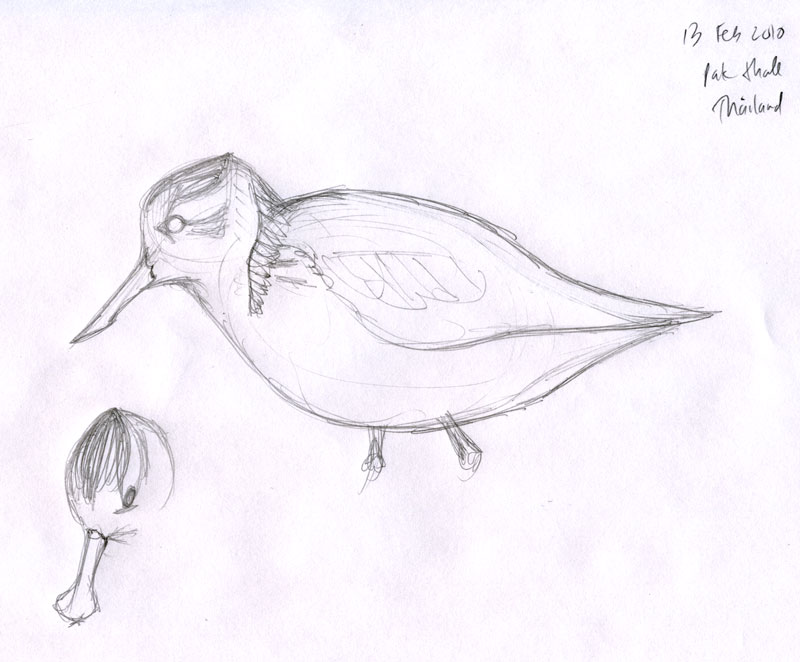
Spoon-billeds also show more white on the rear flanks, which is presumably just a function of the deeper belly creating a greater expanse of white to catch the light.
The nonbreeding plumage of Spoon-billed Sandpiper is basically the same as all other small sandpipers – plain gray-brown above and whitish below. In a direct comparison in similar light most Spoon-billed Sandpipers appear a little grayer than most Red-necked Stints, and most have at least a few scapulars with narrow white fringes all the way around the tips, but these details are so subtle and inconsistent that many other field marks will be noticed before these.
Behavior: Spoon-billed Sandpiper is not immediately obvious by its movements, being very similar to Red-necked Stint. Some subtle details of foraging actions can be helpful to pick out a suspected Spoon-bill. The most common feeding method is to hold the head low and the bill in the water, and move slowly forward. In this mode Spoon-billeds keep their head down longer (making bill shape difficult to confirm) and tend to have the bill more nearly horizontal than Red-necked Stints.
A discussion (and video) of foraging behavior is in my post Bill shape and foraging habits of Spoon-billed Sandpiper.
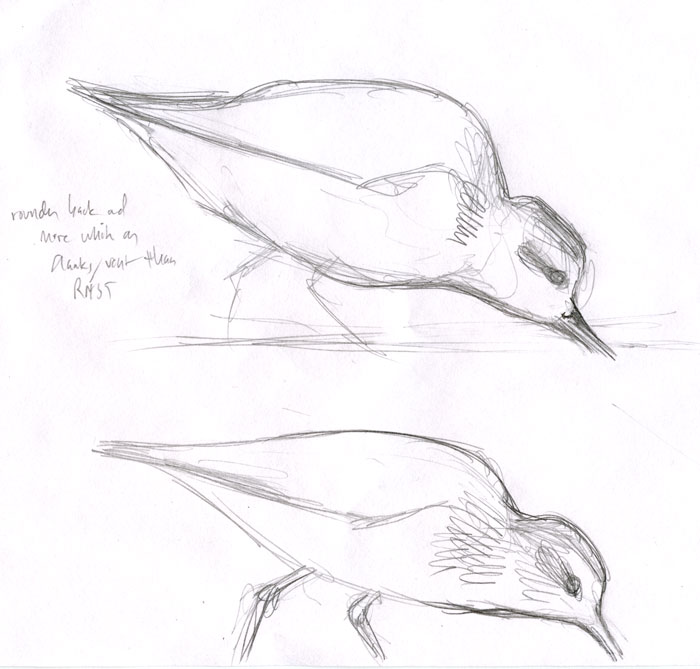
Another common foraging method, in deeper water, is to walk around with head high, jabbing at prey that seems to be found by sight. In this mode they are identical to Red-necked Stint (although differences in head color and bill shape are easy to see).
In general Spoon-bills cover more ground than Red-necked Stints, walking constantly and moving quickly from one patch to another, rather than working back and forth over the same small patch repeatedly. Their walking gait seems to be a bit more methodical and deliberate than Red-necked Stint, not necessarily slower overall, but in particular the forward swing of each leg seems to be slower, while in Red-necked Stint each leg is flicked forward very quickly.
In flight: Nearly identical to Red-necked Stint. About ten times I was able to watch single birds take off and fly past me, and with a good study and not too many other birds I could identify them by the white face, long bill, and small dusky breast “spur”. Just as often the birds would take off in a small flock and I was unable to pick out the Spoon-billed from among the swarm of Red-necked Stints. I had the feeling that the wings were a little whiter underneath than the stints’, and the wingstripe perhaps a bit broader, and the bird a bit larger and more “powerful”. The toes projected slightly beyond the tail tip on one bird I saw well, unlike Red-necked Stint, but this is extremely difficult to see.
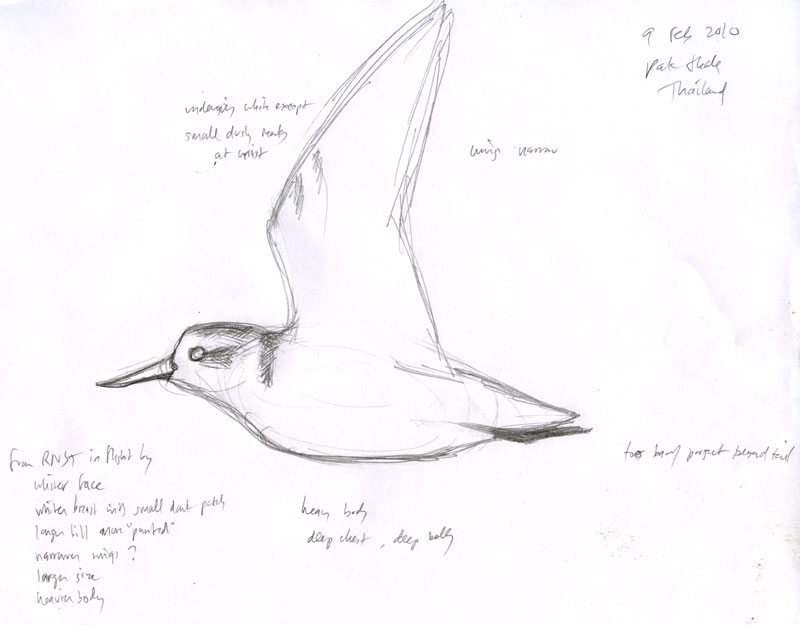
Calls: I heard flight calls three separate times, and each time it was a quiet scraping or hissing sound, relatively long and drawn-out but not at all musical or trilled. One bird gave a call that seemed to fall and then rise in pitch, and another called with a slight and irregular rattle mixed in the scraping sound. The sound was quiet and inconspicuous, and I don’t think I would have noticed it at all except that in each case I was looking at the sandpiper as it took off.
References:
Sauppe, B., B. A. Macdonald, and D. M. Mark. 1978. First Canadian and third North American record of the Spoon-billed Sandpiper (Eurynorhynchus pygmeus). Am. Birds 32: 1062-1064. (pdf here)


This is great stuff. Thanks for sharing the sketches.
Can you help. I was sent an email to identify a bird with pictures but no location . Pair of birds bulging an elaborate nest of mud on a window sill. Ordinary looking birds , maybe Robin size Buffy brown. Have no idea where to find